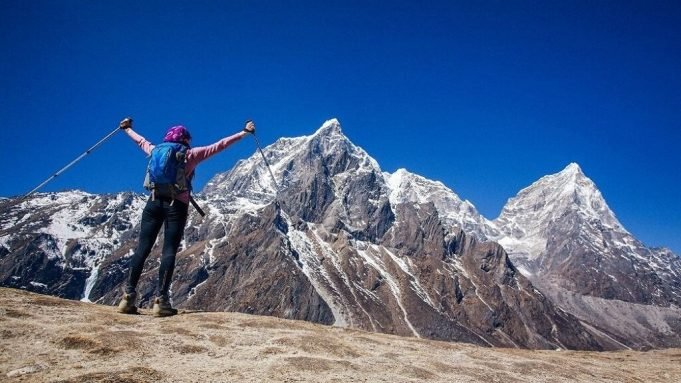Acclimatization Hikes in the Everest Region: The majesty of the Himalayas has beckoned adventurers and explorers from around the world, with the Everest region standing as its crown jewel. As trekkers ascend to these towering heights, there’s an invisible challenge that many face: altitude sickness. This makes acclimatization hikes not just a recommendation, but an essential part of the Everest trekking experience. Understanding the intricacies of these hikes and the science behind acclimatization can be the key difference between a successful expedition and a dangerous retreat.
Understanding Acclimatization
When you climb to high altitudes, your body undergoes an essential adjustment called acclimatization. As you ascend, the air thins, resulting in fewer oxygen molecules with each inhalation. Failing to give your body adequate time to adapt to this drop in oxygen can lead to a severe and potentially fatal condition called Acute Mountain Sickness (AMS).
Acclimatization is your body’s mechanism to cope with the reduced oxygen at higher elevations. Some of the ways the body adapts include:
- Breathing Pattern: Your body compensates for the decrease in oxygen by breathing more rapidly to intake more oxygen.
- Hemoglobin Production: There’s an increase in the production of hemoglobin, a protein in the blood responsible for oxygen transport, to ensure efficient oxygen distribution to body tissues.
- Diuresis Increase: Being at high altitudes can result in more frequent urination, assisting the body in keeping blood pH levels balanced.
- Boosted Metabolic Efficiency: The body enhances its capability to use oxygen more effectively, minimizing the effects of its decreased presence.
It’s crucial to recognize that acclimatization is a gradual process, with individual responses varying from person to person. There’s no shortcut to accelerating this natural adaptation process. Hence, when ascending, it’s vital to progress slowly, allowing your body ample time to adjust to each elevation level before moving higher. This principle is often encapsulated in the advice “climb high, sleep low”, which is pivotal for ensuring health and warding off AMS, especially during high-altitude expeditions like the Everest Base Camp trek.
Acclimatization in the Everest Region
Acclimatization is crucial in the Everest region because of the extreme heights. The Everest Base Camp stands tall at around 5,364 meters (17,598 feet). Venturing to such elevations without the right acclimatization can result in severe health complications like Acute Mountain Sickness (AMS), High-Altitude Pulmonary Edema (HAPE), and High-Altitude Cerebral Edema (HACE).
For a safer Everest Base Camp journey, it’s imperative that your trek schedule includes days dedicated solely to acclimatization. On these days, trekkers either remain at their current height or do short hikes to higher spots and then return to a lower sleeping altitude, facilitating better altitude adjustment.
Two essential stops for acclimatization are Namche Bazaar, situated at roughly 3,440 meters (11,286 feet), and Dingboche, which is around 4,410 meters (14,469 feet). These villages are tactically located along the trekking route, offering ideal conditions for the body to adapt.
In places like Namche Bazaar, trekkers often ascend to the Everest View Hotel or Khumjung Village for short hikes. Meanwhile, in Dingboche, Nangkartshang Peak is a popular choice for such acclimatization hikes.
Proper acclimatization is vital not just for health and safety, but also enhances the likelihood of a successful trek to the Everest Base Camp. It ensures you remain energized and lets you relish the experience, rather than merely enduring it. A golden rule to remember when trekking in the Himalayas is: that it’s less about how fast you go and more about consistent and sustainable progress.
Read More: What to Wear When Hiking in Summer
Importance of Acclimatization
Understanding Altitude Sickness: Causes and Symptoms
At high altitudes, atmospheric pressure decreases, which means there’s less oxygen available. This can lead to a condition commonly referred to as Altitude Sickness or Acute Mountain Sickness (AMS). The symptoms range from mild to severe and include headaches, dizziness, shortness of breath, and nausea. In extreme cases, it can escalate to High Altitude Pulmonary Edema (HAPE) or High Altitude Cerebral Edema (HACE), both of which can be fatal if not treated promptly.
The Science of Acclimatization: How the Body Adjusts
Acclimatization is the process through which the body adapts to the decreased availability of oxygen at high altitudes. Over time, the body increases its red blood cell count to carry more oxygen, deepens the breathing rate, and enhances the capability of tissues to utilize the available oxygen more efficiently.
Consequences of Inadequate Acclimatization
Neglecting the importance of acclimatization can have dire consequences. Apart from the severe health risks mentioned earlier, trekkers might also experience impaired judgment, making them prone to accidents. A rapid ascent without proper acclimatization can lead to a forced and hasty descent, often requiring medical evacuation, which can be both risky and expensive.
Principles of Acclimatization
“Climb High, Sleep Low” Concept
One of the most effective strategies for acclimatization is the “Climb high, sleep low” method. This involves ascending to a higher altitude during the day and then descending to a lower altitude to sleep. This process exposes the body gradually to lower oxygen levels, facilitating better acclimatization.
Hydration and its Role in Acclimatization
Staying hydrated is crucial when trekking at high altitudes. Dehydration can mimic and exacerbate the symptoms of altitude sickness. Drinking adequate water helps the body to maintain its balance and process the decreased oxygen levels more efficiently.
Diet and Nutrition for Altitude Treks
Eating the right foods can make a significant difference. Carbohydrates are the preferred source of energy at high altitudes, so the intake of grains, cereals, and starchy vegetables should be increased. Foods rich in iron, like leafy greens and red meat, can support increased red blood cell production. Moreover, smaller, frequent meals can be more beneficial than larger, spaced-out meals.
Recognizing and Responding to Altitude-Related Symptoms
Being vigilant about one’s health is vital. If mild symptoms of altitude sickness appear, it’s essential to pause the ascent and allow the body to acclimatize. If symptoms worsen, immediate descent is advised. Using supplemental oxygen, medications like Diamox (with consultation from a physician), or rest can also aid in recovery.
Read Also: What to Do If Bitten by a Rattlesnake While Hiking
Popular Acclimatization Hikes in the Everest Region
Namche Bazaar Acclimatization Hikes
Nestled within the heart of the Khumbu region, Namche Bazaar serves as the thriving hub for trekkers, acting as a gateway to the high Himalayas. Known as the Sherpa capital, this town is bustling with energy, featuring markets, lodges, and even internet cafes. Located at an altitude of 3,440 meters, it’s an essential stop for acclimatization.
Namche to Everest View Hotel
A popular acclimatization hike involves a trek up to the Everest View Hotel. Standing at 3,880 meters, it’s a place where trekkers can get a stunning panorama of the Everest range, including peaks like Ama Dablam, Lhotse, and of course, Everest itself.
Namche to Khumjung and Khunde Villages
These twin Sherpa villages, located above Namche, offer a serene hike with a blend of cultural immersion. Visiting the local monastery, witnessing the famous “Yeti Skull”, and savoring the peaceful village life make it an enriching experience.
Scenic and Cultural Highlights
Beyond the mountain views, Namche and its surroundings present opportunities to engage with the Sherpa culture, visit local museums, and even explore the weekly markets where goods from the lower lands are traded.
Dingboche Acclimatization Hikes
Dingboche, situated at 4,410 meters, is another crucial acclimatization stop. Often termed the ‘summer yak pasture’, the village blossoms with barley fields and offers unobstructed views of the Lhotse-Nuptse ridge.
Dingboche to Nangkartshang Peak
A trek to the Nangkartshang Peak provides an elevation gain, which is beneficial for acclimatization. The summit, standing at about 5,615 meters, bestows trekkers with a bird’s eye view of Dingboche and distant peaks.
Exploring the Imja Valley
Meandering through the Imja Valley, trekkers get to witness the pristine Imja Tse River, accompanied by picturesque views of Ama Dablam, Lhotse, and other peaks.
Natural Wonders and Viewpoints
The stupa above Dingboche, the flowing streams, and the unique high-altitude vegetation offer a blend of natural beauty and tranquility.
Lobuche and Gorakshep Acclimatization Options
Lobuche to Gorakshep and Kala Patthar
Starting from Lobuche (4,940 meters), a trek to Gorakshep followed by an ascent to Kala Patthar (5,643 meters) is a popular choice. Kala Patthar, meaning ‘Black Rock’, is famed for its breathtaking sunrise view over Mount Everest.
Gorakshep to Everest Base Camp (EBC)
Continuing from Gorakshep, trekkers can head to the Everest Base Camp (5,364 meters), the base for summit expeditions. The journey offers surreal views of the Khumbu Icefall and glacier.
Glacial Landscapes and Panoramic Everest Views
The glacial moraines, vast icy expanses, and panoramic views of the Everest range make these hikes unforgettable.
Also Read: How to Pack a Backpack for Hiking
Tips for a Successful Acclimatization Hike
Simply resting or sleeping during acclimatization is a common oversight made by many trekkers. To acclimatize effectively, it’s beneficial to explore villages or take short hikes.
Here are several strategies for successful acclimatization on the Everest Base Camp trek:
Stay Hydrated:
Hydration aids in altitude adjustment. Ensure you’re drinking plenty of fluids, including water, herbal tea, soup, and other beverages.
Engage in Short Hikes:
In Namche Bazaar, consider hiking to the Everest View Point for a breathtaking sight of Mount Everest. In Dingboche, a trek to Nagkartsang Peak can be beneficial. These hikes aren’t strenuous and can aid in altitude adaptation.
Deep Breathing Exercises:
Practicing deep breathing boosts oxygen consumption and enhances its distribution to the body’s organs via the bloodstream. Additionally, it can promote an increase in red blood cells.
Consume a Nutritious Diet to Combat Altitude Illness:
It’s essential to eat balanced meals that provide all necessary nutrients. Foods such as garlic soup and those rich in carbohydrates can help fend off altitude-related sicknesses.
Overall, it’s crucial to be proactive in your acclimatization strategies, rather than just resting on designated days. Rely on the guidance and activities suggested by trekking guides to assist in acclimatizing appropriately. Adhering to these recommendations will enhance the likelihood of a safe and pleasurable trekking adventure.
To Know More: What is the Longest Hiking Trail in North America
Conclusion
To sum it up, acclimatization is crucial when trekking to Everest Base Camp. Adhering to the recommendations provided, including staying hydrated, taking short hikes, engaging in deep breathing exercises, and maintaining a nutritious diet, can help ward off altitude sickness.
Always be vigilant about recognizing common signs of altitude illness and don’t hesitate to seek medical assistance if necessary. Effective acclimatization is the key to a safe and pleasant trekking experience.
















[…] READ: Acclimatization Hikes in the Everest Region […]
Comments are closed.